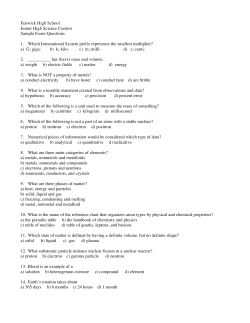
1. Find the orbital period (period of revolution) of... Sun is about 7.8×10
Examples: Kepler's third law PHYS 215 (Introduction to Astronomy) Physics Department – KFUPM 1. Find the orbital period (period of revolution) of Jupiter if its distance from the Sun is about 7.8×108 km. (ae = 1.5×108 km). a = 7.8×108 km = 7.8×108 / 1.5×108 = 5.2 a.u. T2 = a3 Î T = a √ a = 5.2 × √5.2 = 11.86 = 12 yrs. 2. Find the orbital period of Jupiter if its distance from the Earth is about 6.3×108 km when it is in opposition with the Sun. (ae = 1.5×108 km). a = 6.3×108 km + 1.5×108 = 7.8×108 km = 7.8×108 / 1.5×108 = 5.2 a.u. T2 = a3 Î T = a √ a = 5.2 × √5.2 = 11.86 = 12 yrs. 3. Find the orbital period of Jupiter if its angular diameter is about 47" as seen from the Earth when it is in opposition with the Sun. (ae = 1.5×108 km, RJ = 71500 km) θ = 47" = (47/3600) ° = 0.013 ° θ s = 0.013*π/180 rad r = 0.00023 rad. s = linear diameter , θ = angular diameter r = distance , s = rθ s = diameter = RJ × 2 = 71500 × 2 = 143000 km s = rθ Î r = s/θ = 143000 / 0.00023 = 6.3×108 km a = 6.3×108 km + 1.5×108 = 7.8×108 km = 7.8×108 / 1.5×108 = 5.2 a.u. T2 = a3 Î T = a √ a = 5.2 × √5.2 = 11.86 = 12 yrs. 4. It is found that the angular diameter of Jupiter at opposition is θopp = 47" and it is θcon = 32" at conjunction with the Sun as seen from the Earth. Find the distance of Jupiter from the Sun. (RJ = 71500 km) S = 2 × RJ = 2 × 71500 = 143000 km aJ θopp = 47" = 47 / 3600 ° = 0.013 ° = 0.013 × π / 180 rad. Jupiter in conjunction = 0.00023 rad. θcon = 47" = 32 / 3600 ° = 0.009 ° = 0.009 × π / 180 rad. = 0.00016 rad. aJ = (ropp + rcon)/2 = (s / θopp + s / θcon)/2 = 143000(1/0.00023 + 1/0.00016)/2 = 143000(10598)/2 = 7.6×108 km rcon The sun Jupiter in opposition ☼ The Earth ropp Examples: Kepler's third law PHYS 215 (Introduction to Astronomy) Physics Department – KFUPM 5. In order to find the mass of the Moon a space craft is made to orbit around it. Find the mass of the Moon if the space craft is orbiting at a height of 127 km above its surface with a period of 2 hrs. Also find the orbital speed of the space craft.(Rm = 1738 km, G = 6.67×10-11 m3/kg.s2) T2 = (4π2/GMm) a3 Î Mm = 4π2×a3/G×T2 = 4π2×(127000 + 1738000)3/G×(2×3600)2 = 7.4×1022 kg v = 2π×a/T = 2π×(127 + 1738)/2 = 5859 km/hr = 1.63 km/s v = √G×M/a = √6.67×10-11 × 7.4×1022 / (127000 + 1738000) = 1627 m/s = 1.63 km/s 6. How long Hubble Space Telescope (HST) takes (in minutes) to circle once around the Earth if it is at a height of about 600 km above the Earth surface? (R⊕ = 6400 km, G = 6.67×10-11 m3/(kg.s2), M⊕ = 6×1024 kg) P 2 = (4π 2 / G M) a 3 P = √ 4π 2 (600000+6400000)3 / 6.67×10-11 × 6×1024 = 5817 seconds = 97 minutes 7. How fast Hubble Space Telescope (HST) is moving (in km / s) as it circles the Earth at a height of about 600 km above its surface? (R⊕ = 6400 km, G = 6.67×10-11 m3/(kg.s2), M⊕ = 6×1024 kg) P 2 = (4π 2 / G M) a 3 Î P 2 / (4π 2 a 2) = (1 / G M) a = 1 / v2 v =√GM/a = √ 6.67×10-11 × 6×1024 / (600000+6400000) = 7561 m / s = 7.6 km / s or 8. v = 2π a / P = 2π(600000+6400000) / 5817 = 7561 m/s = 7.6 km / s How fast Hubble Space Telescope (HST) is moving (in degrees per minute) as it circles the Earth at a height of about 600 km above its surface? (P = 97 min.) 360 º in P sec. Î ө º in 1 sec ө = 360 / P = 360 / 97 = 3.7 º / min. = 223 º / hr. = 14.85 revolutions per day = about 15 rev. per day Phys 215: alshukri@kfupm.edu.sa Introduction to Astronomy Physics Department KFUPM , Dhahran Saudi Arabia
© Copyright 2025





















